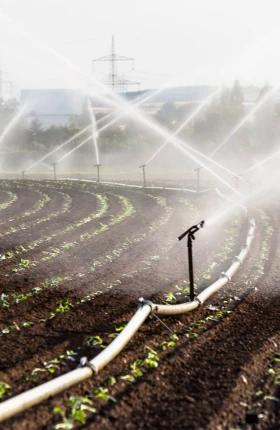The parched city of Cape Town, enduring its worst drought in more than a century, faced a water crisis in early 2018. The shrinking reservoirs serving the 4 million residents of South Africa’s second-largest city could run dry within three months, authorities warned. Water rationing was imposed citywide.
Cape Town’s dire situation is just one example of water shortages that are occurring worldwide and are expected to become more frequent and more severe as a consequence of climate change and demographic pressures.
The disruption and risk imposed on businesses and economies can be substantial: crippled production lines, broken supply chains, and interrupted delivery of products and services to customers. Company supply chains are more dependent on flowing water than either customers or the companies themselves realize. Producing a single cotton T-shirt, for example, can require 2,700 liters of water, much of it used to grow the cotton.
As water pressures grow, businesses today can take positive steps beyond simple risk mitigation. Companies with water-dependent supply chains increasingly stand to benefit by investing in sustainable water projects. Carefully placed investments that are relevant to a company’s core business have the potential to generate substantial financial returns—for both businesses and commercial investors.
Chronic Underinvestment, Despite Rising Risks
Freshwater flows around the world are increasingly threatened—by proliferating dams that fragment rivers; by overuse of water for agriculture, industry, and urban living; and by the destruction of wetlands. Poor governance of water resources and aging infrastructure contribute to damage caused by pollution and the degradation of natural ecosystems. Extreme weather conditions induced by climate change, meanwhile, will exacerbate the situation by making rainfall and river flow patterns increasingly unpredictable. (See the sidebar.)
Going, Going, Gone
Going, Going, Gone
The earth’s freshwater ecosystems are being destroyed and degraded at an alarming rate, despite their importance as sources of drinking water, crop irrigation, food, hydropower, and transport. The damage, along with increasing demand, has put unprecedented pressure on the world’s water supplies. And that pressure is growing.
Since 1970, 35% of the world’s remaining wetlands have been drained, filled, planted, or paved, according to the Ramsar Convention on Wetlands’ 2018 Global Wetland Outlook report. Just a third of the world’s 177 longest rivers (620 miles and longer) remain free-flowing, unimpeded by dams or other barriers. Only 21 rivers longer than 620 miles retain a direct connection with the sea.
Around the world, more than 1 billion people lack access to clean drinking water and 2 billion don’t have adequate freshwater sanitation. Nearly half of the world’s population lives in regions lacking access to basic levels of fresh water for at least one month a year, and water scarcity now affects three-quarters of all irrigated areas.
More than 2 billion people globally inhabit countries with what the UN calls “excess water stress,” defined as the removal or loss of more than 25% of a country’s freshwater resources. Northern Africa and Western Asia experience water stress levels exceeding 60%, according to the UN, indicating strong likelihood of future water scarcity.
Yet despite growing water-related risks to businesses and economies, projects to develop sustainable water infrastructure and management resources suffer from significant, chronic underinvestment worldwide. This funding gap is illustrated by the capital investment needed to meet the UN sustainable development goal to “ensure availability and sustainable management of water and sanitation for all” by 2030: $1 trillion worldwide annually for water infrastructure projects alone, according to the Organisation for Economic Co-operation and Development.
Companies, knowingly or not, are therefore placing major bets and taking substantial risks if they remain dependent on the quantity and quality of water they consume today. Risk reduction, at a minimum, requires them to scale back that dependence—as well as reduce the impact of their operations and value chains on freshwater sources.
Sustainable Water Investments That Pay Returns
Forward-thinking companies and commercial investors will benefit by acting more boldly. They will identify solutions and fund sustainable water projects that further the social goals of improved water resource management while supporting the business requirements of financial performance and sustainable growth.
Indeed, research by Boston Consulting Group has found evidence that robust environmental, social, and governance (ESG) practices, as elements of a company’s “total societal impact” (TSI), correlate with better financial performance including higher total shareholder returns. TSI is the total benefit to society from a company’s products, services, operations, core capabilities, and activities. (See Total Societal Impact: A New Lens for Strategy, BCG report, October 2017.)
Companies that invest more in water resource management, and other environmental initiatives, outperform their peers, the research found. A quantitative analysis by industry sector showed that better water resource management was one of three key ESG metrics driving better financial performance for consumer goods companies. Companies that were top performers in water management, responsible environmental footprint, and investment in food safety management were awarded 11% higher valuation premiums by investors. Enhanced conservation of water use, alone, correlated to higher earnings of 3.1 percentage points, as measured by EBITDA, and gross margins that were 5.5 percentage points greater.
Companies that invest more in environmental initiatives outperform their peers.
“Bankable” Projects
Our experience shows that companies and commercial investors can pursue a number of “bankable” projects that can reduce water-related risk and/or increase profitability. They include:
- Supply-side projects, such as better utility management including installation of smart monitors to reduce leakage, and ecosystem restoration to mitigate water pollution, droughts, and floods
- Demand-side projects, including agricultural and industrial efficiency efforts that reduce reputation, regulatory, and physical risk by using less water or causing less water pollution while reducing energy consumption and costs
In addition to increasing the resilience of businesses dependent on water, such investment efforts also tend to exert pressure on local authorities to improve water governance by strengthening regulation and enforcement. Water is a shared resource; comprehensive derisking requires better practices across the entire watershed.
Case Study: Turkey’s Büyük Menderes River Basin
One successful bankable project will significantly improve water quality in the Büyük Menderes river basin in southwestern Turkey, the site of extensive textile manufacturing. The project, undertaken by the World Wide Fund for Nature (WWF), could serve as a blueprint for similar efforts worldwide.
The river is a vital source of water for the region, an area of rich biodiversity. But the native flora and fauna and the quality of life of local people have been increasingly threatened by water pollution from textile manufacturing near the industrial city of Denizli. That pollution was also harming downstream industries including fishing and cotton farming—a vicious cycle given that the textile industry depends on cotton.
WWF determined specific steps that small and medium-size enterprise (SME) textile dyers could take to cut costs while limiting their environmental footprint by reducing use of water, chemicals, and energy. These ranged from small process alterations, such as changes in chemicals and better water management, to more substantial investments in equipment. WWF helped the textile dyers attract grants to fund feasibility studies and created protocols with participating banks to facilitate obtaining loans for investment in cleaner production processes. The protocols allowed local banks to assess, approve, and process SME loan applications more efficiently.
The changes yielded significant savings, with payback periods ranging from six months to two years.
A Missed Opportunity for Big Companies and Investors
Despite the financial benefits of environmental diligence, many global corporations and investment firms are missing in action when it comes to investing in water solutions—even when doing so would directly serve a company’s business needs.
Companies and investors cite various reasons for the weak response. For example, some note that many projects are in frontier or emerging markets where local sponsors, public or private, often lack experience and an adequate track record, or where seed funding is insufficient to develop initial business plans and test feasibility. Others point out that long-term loans required for capital-intensive projects are hard to come by in riskier emerging markets, especially for water projects. Water governance is often politicized because water is a human right—making it a social priority first and foremost, ahead of its role as a commodity. Progress often has been hampered by inadequate regulation or by the complexity of water systems that cut across administrative areas and river basins and thus are governed by differing regulations. Finally, some international investors say, many water projects are simply too small to attract large-scale commercial financing.
An Emerging Ecosystem of Water Solutions
The absence of corporate and investor leadership and ambition in sustainable water funding is unfortunate, both for companies and for the world’s water resources. Failure to act will soon be outdated, given that increasing sources of shared support are available to help the private sector invest in sustainable water solutions and accelerate the pace and scale of urgently needed funding. (See Seizing the Water Opportunity, a report by WWF, ING Bank, and BCG, October 2018.)
The UN’s sustainable development goals encourage all stakeholders to build multistakeholder partnerships in order to implement the 2030 agenda. As a result, many development-sector organizations are rethinking their programs to tap the capabilities and resources of the private sector.
Nongovernmental organizations and development agencies want more than ever to unleash the private sector’s resources to deliver solutions at scale. For example, WWF is setting up a comprehensive framework of programs to help the private sector invest in projects that are both bankable and sustainable. They include a global network of freshwater experts in the field who can identify projects and coach local project sponsors, a seed fund to finance early stages such as feasibility studies, and an advisory panel of financial institution representatives to ensure that projects are truly bankable. WWF has also created the Landscape Finance Lab, a platform to share investment opportunities with potential investors.
Companies and financiers no longer have to enter the freshwater investing fray on their own. Development banks and foundations now offer blended finance solutions to attract commercial investors. These instruments can fund initial development stages with grants or concessional loans, take on junior loans, and provide risk coverage to improve the risk-return profile of investments for commercial players.
Today, the financial sector has growing access to a variety of mechanisms that can increase the scope and viability of sustainable water investments and projects. These include umbrella “blue bonds” that provide financial support for multiple water projects. Another example is corporate sponsorship for aggregating multiple lines of credit for individual vendors or contractors—such as credit for suppliers cooperating on efficiency improvements for a single blue-chip company based on meeting predetermined criteria.
More tools are also becoming available for companies to assess the risk and financial impact of potential water projects to support specific operations or their value chain. For example, WWF’s upgraded Water Risk Filter Tool enables businesses and investors to assess water-related risks on the basis of activity and location. The tool permits companies to calculate the value or cost of that risk, measuring its potential effect on their financial results.
The financial sector has growing access to mechanisms that can increase the scope and viability of sustainable water investments.
Money managers and prospective shareholders increasingly take sustainability into account when placing their investments. In 2016, global sustainable and responsible investing (SRI) increased to more than a quarter of total assets under management, according to the Global Sustainable Investment Alliance. Among European investors, that share has quickly grown to 50%. Companies are able to access a growing array of sustainable finance products. The value of green bonds has grown 14-fold between 2013 and 2017. While they are still niche, green bonds are expected to total 5% to 15% of the global debt market by 2020.
We are starting to see examples of green bonds that allow companies to finance projects they could not otherwise fund or that reduce the cost of debt for projects with superior environmental performance in the medium and long terms. Positive incentive loans, which reward companies with discounts or premiums based on ESG performance, are a fast-growing product providing liquidity in the short term.
A Corporate Call to Action
While supporting water sustainability may seem daunting, now is the time for companies to become part of the solution. Based on our collaboration with companies and NGOs on sustainability issues, we believe businesses and investors can best engage the emerging ecosystem by prioritizing several specific steps and initiatives.
Among these priorities is to identify potential projects across a company’s entire value chain. This process can be eased by enlisting the help of local and technical partners such as NGOs and development agencies and by using relevant tools. Companies can identify material issues—such as water-related risks, excessive costs, and missed revenue opportunities—and then build the business case to tackle them.
Now is the time for companies to become part of the solution.
Businesses and investors should also support local project sponsors by sharing their expertise and networks, and seeking financial support and technical advice from development agencies in return. It is particularly useful to provide local suppliers and distributors with knowledge of good practices tried and tested elsewhere, and facilitate their access to funding, including financial resources and mechanisms usually available only to large businesses.
Another critical step is to ensure that sustainable water efforts involve collective action and that they support improved governance and broad change across the entire watershed. Companies should engage local users and authorities in supporting better water resource management, and embark on a path of shared benefits.
Finally, companies should broadcast their success internally and externally, to their investors and the wider business and financial community, to make sure their efforts gain broad support and are rewarded. Clearly communicating the proactive management of major issues will result in premium valuation from a growing segment of investors, and it will encourage other stakeholders in the watershed to take part.






